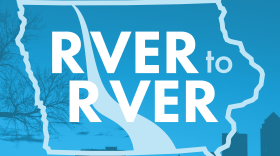Caleb Sinnwell was helping out on his family's hog farm when he got an unexpected call — from Iowa Sen. Chuck Grassley in Washington D.C.
The senator was contacting Sinnwell to throw his support behind a years-long effort the high school student had recently become a part of: urging lawmakers to officially recognize and honor members of America's Ghost Army, a WWII deception unit that had been kept secret for half a century after the war.
“The first thing that he said was that he was co-signing the bill that I was lobbying for," Sinnwell recalled on IPR's River to River. "That was a really happy, exciting moment.”
Grassley's support helped gain bipartisan congressional support for the bill that was signed into law by President Joe Biden in 2022, and this spring, the Congressional Gold Medal was awarded to the Ghost Army's living and deceased members at the U.S. Capitol. But the journey to the ceremony took years of research, advocacy, lobbying — and Sinnwell's high school history project.
A battle of deception
The Ghost Army was created late in 1943, conceived by two staff officers in England: Major Ralph Ingersoll and Col. Billy Harris. It was designed to be a deception unit; 1,100 men stationed in southern Europe — and another 200 in Italy — would pretend to be a force of up to 30,000 to fool the Germans about the location and size of American units. To do so, a myriad of tricks and illusions were employed. The army would use inflatable tanks, trucks and jeeps, create fake airfields and record phony radio transmissions to deceive the enemy. It's believed their efforts saved thousands of lives.
“There's a lot about the Ghost Army that is whimsical," said Rick Beyer, an author and filmmaker who spent nearly two decades researching the unit for a book and documentary that would reveal the true story of the Ghost Army. "You're working with inflatables. You're keeping secrets from fellow American soldiers. You're doing stuff that seems diametrically opposite to what we think of as frontline soldiers doing."

Three people were killed carrying out the deceptive missions, and several others were wounded, but since records of the unit weren't declassified until 1996, many were not given purple hearts. Beyer, who formed the Ghost Army Legacy Project in 2015 to lobby for a Congressional Gold Medal, said that's one of the reasons he became so dedicated to ensuring the unit was honored.
“It was a crazy, wacky mission, but they risked their lives to do it — and it worked," he said. "I think that's a pretty amazing thing that people should remember.”
The road to recognition
While Beyer and the legacy project worked for seven years and through multiple congressional sessions to gain lawmakers' recognition of the Ghost Army, its history was sought out by Sinnwell — then a 9th grader — for his National History Day school project.
“It was a top-secret unit, so there wasn't a whole lot published on it. The most of the knowledge I got was from Rick and his interviews with the Ghost Army veterans," Sinnwell said.
He emailed Beyer and interviewed him for the project, which ended up winning a state prize. As he prepared to move on to the national competition, Beyer asked the 14-year-old if he'd like to help them lobby for the Congressional Gold Medal. Sinnwell eagerly agreed.
“I think one of the things that's really evident when you meet Caleb is his enthusiasm, and I'm pretty sure that's what Rick recognized when he invited Caleb to become part of the Ghost Army lobbying group," said Suzan Turner, Sinnwell's Talented and Gifted teacher, who served as an advisor for his history project. “Once Rick invited Caleb to lobby, the rest is history. I mean, he just dove in. Every day he was calling, he was emailing.”
The Ghost Army Legacy Project had already been lobbying for several years before Sinnwell joined the effort, and in less than a year, he'd earned the support of a senator in Mississippi and Grassley, who brought on other co-sponsors. After the bill was signed into law, the United States Mint worked for two years on the design of the custom bronze medal before the ceremony was held.
"Rick had done all that groundwork, and with all the other people that it just seemed like it needed to get a little extra boost, and I think Caleb played a role in that," Turner said.
The ceremony, held on March 21 at the U.S. Capitol, honored the six known surviving members of the Ghost Army and its deceased members. Three veterans were in attendance.
“I can't possibly pick out one thing that was my favorite other than them finally getting the recognition and … everybody getting what they deserve, but I think the best thing was them getting their medals," Sinnwell said of attending the ceremony. "I think that was probably the biggest thing I will take away, was seeing their faces when they got presented the medals that they've been trying to work for, for a while, for all this time, and they finally got to get them.”

David Cantrell, the son of Ghost Army veteran and Iowan John Cantrell, also attended the ceremony. John served as a radio operator for the army, impersonating operators from other units, and died in 1990 before the Ghost Army was declassified. He was quiet about his past and wouldn't talk about it often with his children, but David said he was able to piece together his father's war experience with Beyer's Ghost Army research when he found a box of his father's military mementos.
“The ceremony itself was just outstanding, overwhelming and very humbling to see," he said. “I think Dad would say that he was just an ordinary guy. But he and his buddies did extraordinary things.”







